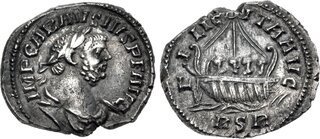| Classical Numismatic Group > Triton XXVII | Auction date: 9 January 2024 |
| Lot number: 874 Price realized: 6,000 USD (Approx. 5,495 EUR) Note: Prices do not include buyer's fees. | Show similar lots on CoinArchives Find similar lots in upcoming auctions on |
| Lot description: Carausius. Romano-British Emperor, AD 286-293. AR Denarius (20mm, 4.81 g, 6h). 'RSR' mint. IMP CARAVSIVS P F AVG, laureate and draped bust right / FELIC ITA AVG, galley on waves, with mast and four rowers, sailing right; RSR. RIC V.5 86 (forthcoming); RIC V 560; Shiel 47; RSC 50. Toned, light porosity, light scratches mostly under tone, metal flaw at edge. Near EF. Well struck and in good metal. A detailed specimen of a very difficult issue. Very rare, only 9 examples noted in RIC V.5. From the Dr. Malcolm Lyne Collection, purchased from Baldwin's, 16 December 2003. Sir Arthur Evans suggested in 1928 that the 'RSR' mark in the exergue "[can] be explained as R[ationalis], S[ummae] R[ei] rather than a local mint mark" (as cited in Shiel 1977). Shiel followed Evans' explanation and suggested that "one would expect to find such an officer based at the administrative centre of the area concerned, in this case London, and so the denarii ... must have been produced there also" (Shiel, 98). Alternatively, Guy de la Bédoyère proposed a more literary explanation for the three letters in his article "Carausius and the Marks RSR and I.N.P.C.D.A." in NC 1998. His explanation draws upon the enigmatic letters INPCDA found on a pair of large bronze Carausius medallions and extrapolates from the two sets of exergual letters that they are a reference to a passage from Virgil's Ecologues iv.6-7 which reads "Redeunt Saturnia Regna, Iam Nova Progenies Caelo Demittitur Alto" (de la Bédoyère, 82). De la Bédoyère suggests that perhaps at the least the RSR-marked silver denarii of Carausius were likely not intended for widespread general circulation but were instead donatives for the state's elite (ibid, 85). The substantial weight of the denarii and their metal quality lends some credence to this hypothesis. Both Evans' and de la Bédoyère's explanations are offered here for this intriguing and artistic series. The Coinage of Carausius from the Dr. Malcolm Lyne Collection When one considers the coinage of the Romano-British Empire led by the rebels Carausius and Allectus, the following adjectives do not usually come to mind: stunning, captivating, intriguing, entrancing, and more. However, the collection of Romano-British coinage that Dr. Malcolm Lyne has assembled is without doubt one of the finest known today. Perhaps never before has such an extensive and high-quality offering of the coinage of Carausius appeared on the market in a single sale. These extremely difficult issues are rarely encountered in excellent states of preservation or with many of the incredible pedigrees that are found within Dr. Lyne's collection. Furthermore, these coins have been studied by the author of the upcoming RIC V.5, Sam Moorhead, who has graciously provided critical updated catalog numbers and rarity information. As the numismatic community awaits the upcoming new versions of RIC 5, a preview of the wealth of information to come can be found here. It should be noted that it has been ninety years since the original publication of the old RIC V.2 in 1933. However, many issues in this collection that were known then remain incredible rarities. Some of these issues that were either formerly unknown or known from precious few examples are today still unique, extremely rare, or very rare. Furthermore, many them are not only near peer-less in rarity, but are also incredibly attractive specimens. On top of these desirable traits, there are also outstanding pedigrees attached from famous collections. Many of these old pedigrees feature the names of famous numismatists who studied and wrote on the coinage of Carausius in the 20 th century. Additionally, some of the coins found in this section are appearing here again for the first time in a generation making this a rare opportunity to acquire seldom encountered or even unique issues. This sale and its pedigree name are certain to be remembered in future work as a major moment for the coinage of Carausius. Estimate: 5000 USD |  |



